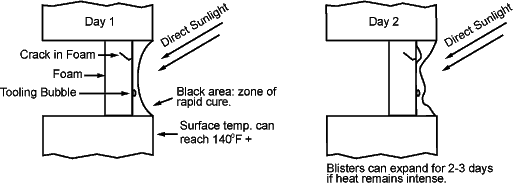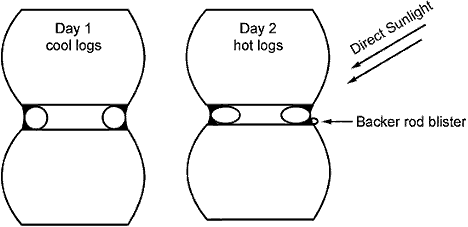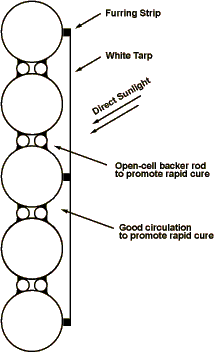Can I stain before caulking or chinking?
When applying water-based caulk and chinking like Conceal, Energy Seal, Log Builder caulking, Log Jam chinking, or Perma-Chink, and using a water based stain, it may be applied before of after staining. If using oil-based finishes like NatureColor Base or Recoater, Woodguard, or WR-5:
1. Apply caulk or chinking over one coat, and then apply a second coat of finish the following year.
2. Wait at least 21 days after staining before caulking or chinking to allow for cure time. (Paraffinic oils like in X-100 can cause adhesion failures.)
Do I need backer rod?
Yes, if chink joints are greater than 1/4". See Backer Rod and Chinking.
What does the temperature need to be to apply caulk or chinking?
See "Surface Preparation".
What can I use to smooth out my caulking or chinking?
People use various kinds of "tooling" devices. The most popular would probably be a spatula of some sort at the desired width. Some people use a cake spatula if an industrial one is not available. Butter knives, rubber spatulas, and foam brushes have also been used.
How do I prevent blisters from forming in log home caulk and chinking?
Click here for details.
I have flat on flat logs, what do I put between them?
There are a couple of alternatives to put in between logs for a flat on flat system:
1. The first is to lay a bead of adhesive caulking on each side of the log; see Conceal or Woodsman Caulking.
2. The other alternative is a product called LogSeal. Some of the features of LogSeal are sealing against water, cold, heat, light and noise. LogSeal has adhesive on one side with an easy-release protective liner, providing fast and easy placement during construction. LogSeal provides easy application for flat on flat and saddle notch systems. When using for flat on flat construction, lay one line of LogSeal on the outer edge and one line on the inner edge.
Do I need to caulk after using LogSeal?
Yes. It is always important to seal the exterior side with log home caulk or chinking to keep moisture (in the form of rain or splash-back) out from the log joints. The log caulking also helps to keep insects from working their way in.
Should I buy a 5-gallon pail or tubes?
Economically, it is better to buy a 5-gallon pail; however you don't start saving money until you purchase two 5-gallon pails because of the cost of tools for pail application. A 5-gallon pail is equivalent to twenty-two 29 oz. tubes. It will also depend on what the you feel comfortable with, caulking tubes or a bulk loading gun.
If I buy a 5-gallon pail, how do I get it into my caulk gun?
By using a Follow Plate.
How do I clean and take care of my Albion bulk loading gun?
See "Care of Albion Bulk Loading Guns".
How to Prevent Blisters in Caulk and Chinking
Occasionally, blistering of a chinked or caulked surface occurs. A chinked area is more susceptible to blistering due to the larger joint size. After several years of investigation, Sashco Sealants has uncovered most or all of the causes* of this problem and can recommend ways to prevent it.* At first it was thought that the chinking itself was to blame. But the facts do not support this. For example:
The Causes are Site related and not product or batch related.
Causes of Blisters: The basic cause of any blister is a build-up of gas between the log, the backing surface, and the chinking or caulking. It occurs during The early curing stages when The chinking is soft but has a skin formed on the surface. Heat usually in the form of direct sunlight causes the gas to expand. As the gas expands, it pushes the chinking out, causing a "bubble" or blister. This gas comes from water, wood sap, or even backing material.
What Circumstances Create the Gas? Trapped Water Vapor. As chinking and caulking dries, it gives off water vapor. Any physical condition which traps the resulting water vapor could cause a blister, especially if the logs and chinking are heated by direct sunlight here are some things that could trap this vapor.
Note Manus-Bond Caulking is not affected by water vapor in the same as other caulking or chinking because it is a polyurethane. Moisture makes it set up faster and will not generally cause blistering.


Backing Material Backer rod out-gassing. Closed cell backer rod has a puncture and is squeezed by expanding logs. The gas used to make the rod forces a blister in the chinking and caulking.
On Day 1 the backer rod and sealant are applied in the cool part of the day. On Day 2 the sun comes out and heats the logs. This causes the backer rod to be squeezed, and forces a small amount of gas in the backer rod to leave the rod at a rupture or weak spot and make a blister in the sealant. The phenomenon has been known to occur in the caulk and sealant industry for many years and occurs randomly and unpredictably.

 Pitch Pockets Logs often have what is termed "pitch pockets." These are areas of concentrated pitch, or sap, sometimes containing several gallons! (Pitch pockets of 50 or more gallons are known!) This sap (or its vapor) will follow cracks in logs, coming out of the log almost anywhere. It especially exits at the knots Where the sap flow was directed during the life of the tree. Sap has a volatile component and, when heated, forms a gas that causes blisters. Some blisters appear to be in the dead center of the chinking/ caulking. Upon close investigation, however, most or all of the bubbles are connected to a crack in the log surface. The blisters are often the result of sap vapor, which can come through the tiniest of holes in the wood. Pitch pockets are often the cause of blisters, which line up in a straight row. They are simply aligned with the crack in the log along which the sap is traveling. In the heat of direct sunlight some of the liquid sap in the pitch pocket turns into a gas that is under pressure and can form a blister as it tries to escape the log.
Pitch Pockets Logs often have what is termed "pitch pockets." These are areas of concentrated pitch, or sap, sometimes containing several gallons! (Pitch pockets of 50 or more gallons are known!) This sap (or its vapor) will follow cracks in logs, coming out of the log almost anywhere. It especially exits at the knots Where the sap flow was directed during the life of the tree. Sap has a volatile component and, when heated, forms a gas that causes blisters. Some blisters appear to be in the dead center of the chinking/ caulking. Upon close investigation, however, most or all of the bubbles are connected to a crack in the log surface. The blisters are often the result of sap vapor, which can come through the tiniest of holes in the wood. Pitch pockets are often the cause of blisters, which line up in a straight row. They are simply aligned with the crack in the log along which the sap is traveling. In the heat of direct sunlight some of the liquid sap in the pitch pocket turns into a gas that is under pressure and can form a blister as it tries to escape the log.
Prevention of Blisters Some of these causes cannot be controlled. Two factors can be partially controlled - heat and backer rod selection/preparation. Since heat normally is responsible for turning undetected gas into unsightly blisters, it makes sense to control this element as much as possible. Once the chinking and caulking has become firm, it can then resist the low pressure from the water or sap vapor and the blisters can then be prevented.
 Control the Heat:
Control the Heat:
Control the Backing Material:
 A fresh blister can sometimes be eliminated by puncturing the surface skin (to let the moisture vapor escape) and pushing the chinking and caulking back into place. This step can cause marring of the chinking finish, but can be smoothed out 2-3 days later (after the chinking has firmed up) with a small amount of Log Jam applied and smoothed. Often the blister will not reappear. To be effective, this action must be taken within the first day after application, while the underlying chinking and caulking is still wet This method can be the most effective and efficient since the blisters are caught very early (before they become very large) and repaired quickly.
A fresh blister can sometimes be eliminated by puncturing the surface skin (to let the moisture vapor escape) and pushing the chinking and caulking back into place. This step can cause marring of the chinking finish, but can be smoothed out 2-3 days later (after the chinking has firmed up) with a small amount of Log Jam applied and smoothed. Often the blister will not reappear. To be effective, this action must be taken within the first day after application, while the underlying chinking and caulking is still wet This method can be the most effective and efficient since the blisters are caught very early (before they become very large) and repaired quickly.